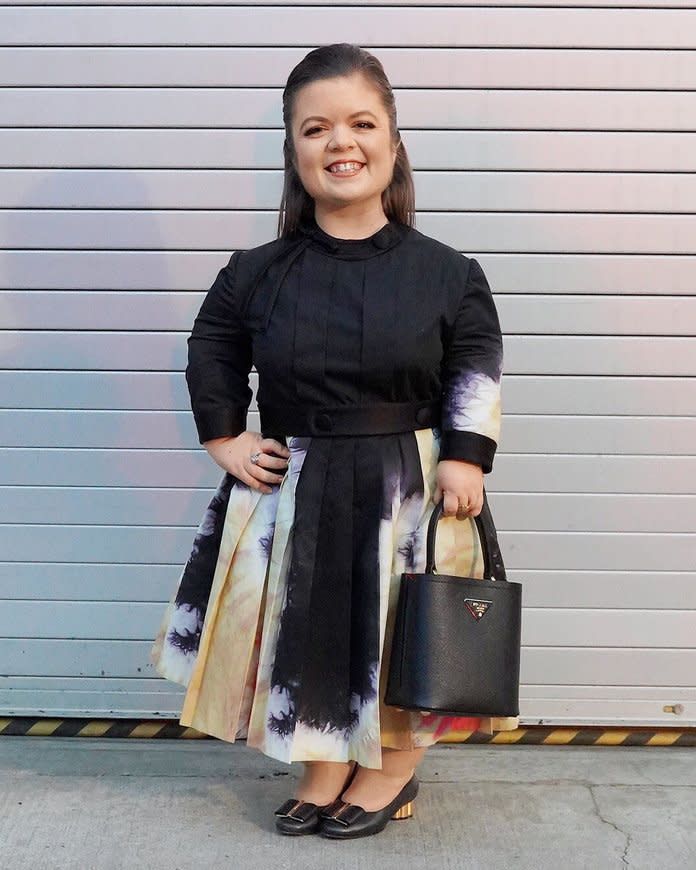Sinéad Burke on the Shoes She's Waited a Lifetime to Buy
As a self-proclaimed fashion aficionada, I can categorize most of my life by very specific shoes. Brown boating shoes shaped my teenage years. Odd, perhaps, as I never took an interest in sailing, but when I was growing up in Ireland, they were part of the uniform at my all-girls Catholic school. They were designed by a local company, Dubarry, and the leather only began to soften and become comfortable toward the end of the school year. I’m not sure who decided that they were academically appropriate, but they’re still part of the school uniform today. They’ve haunted me for almost a decade.
Pink loafers with enormous bows were the most significant and well-worn shoes of my early adolescence. I bought them in the children’s department of a high-street retailer, and there was never a time when I questioned if they complemented the day’s outfit. I wore them with everything — pajamas, a ball gown, and even track pants if I needed to do a coffee run. They’re past the point of repair now, but I still have them. They’re stored in a box under my bed, and every now and again I peer in to admire them. Those shoes brought me to so many places. I was wearing them when I began to discover who I was and what I wanted to do with my life. In a strange way they remind me that anything is possible.
Of course, finding the right shoes as a disabled little person has not been easy. My feet are a size 12 in the children’s department. And while I’m not in favor of creating high heels for children, I’m now close to 30 and have spent much of my life desperately wanting the types of shoes that my nondisabled friends can wear.

Late last year everything changed when I sat next to Ferragamo’s creative director, Paul Andrew, at the Green Carpet Fashion Awards in Milan. “We should make custom shoes together,” I told him. I said it with a wink so that I could pass it off as a joke if he didn’t like the idea. Inside, though, I was quite serious. And to his credit, so was he. Soon I was meeting the craftspeople who make Ferragamo’s footwear and learning about each of the 40 stages required to make one shoe. It was a humbling experience, and I finally have a pair of high heels. They’re a classic black Vara pump adorned with a gold flower-shaped heel [above]. They’re simple yet elegant and prove that with good design, the potential is limitless.
Those pumps and I have been to some pretty amazing places. I wore them on the cover of British Vogue’s September issue, to my appointment as a member of Ireland’s Council of State, and to chance encounters with Cate Blanchett, Phoebe Waller-Bridge, and even Jacinda Ardern, the prime minister of New Zealand. Most recently, I wore them to Victoria Beckham’s spring 2020 show, where Dame Helen Mirren and I plotted ways to redesign uncomfortable knickers.
Since I first became interested in fashion, footwear options [for little people] have improved. I can happily report that Gucci loafers and shell-toe Adidas sneakers have worked their way into my wardrobe. My shoes now tell the world that I am an adult, and they give me the respect, agency, and autonomy I deserve. I’m very grateful for all that has been made available to me, but there is more to be done. Design can unite us or make us feel more alone, and shoes are a physical and symbolic way of measuring our jaunt through life. My mission is to bring design and disability closer together. I won’t rest until beautiful, eye-catching, and magnificent shoes can be enjoyed by all.
Burke is the host of the new podcast As Me with Sinéad from Lemonada Media.
For more stories like this, pick up the November issue of InStyle, available on newsstands, on Amazon, and for digital download Oct. 18.

